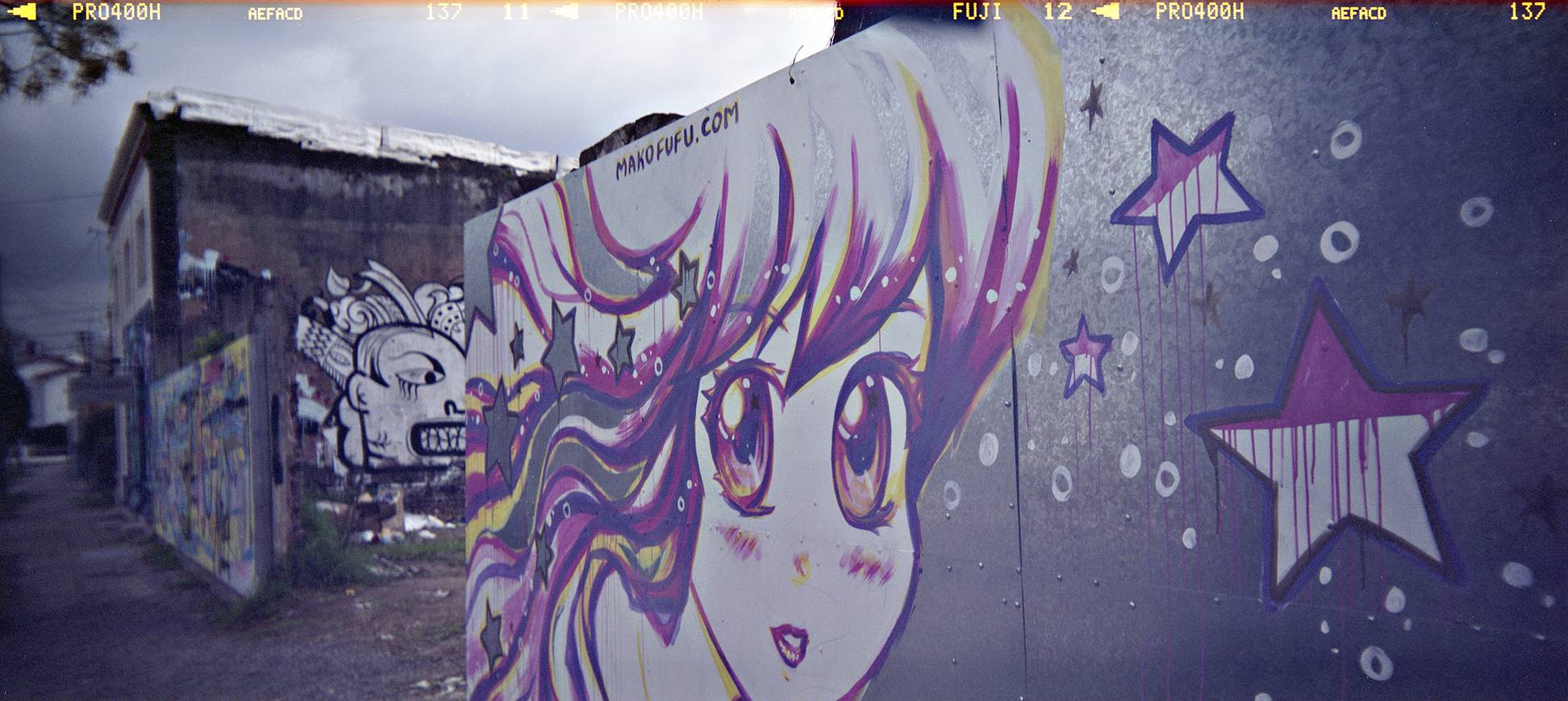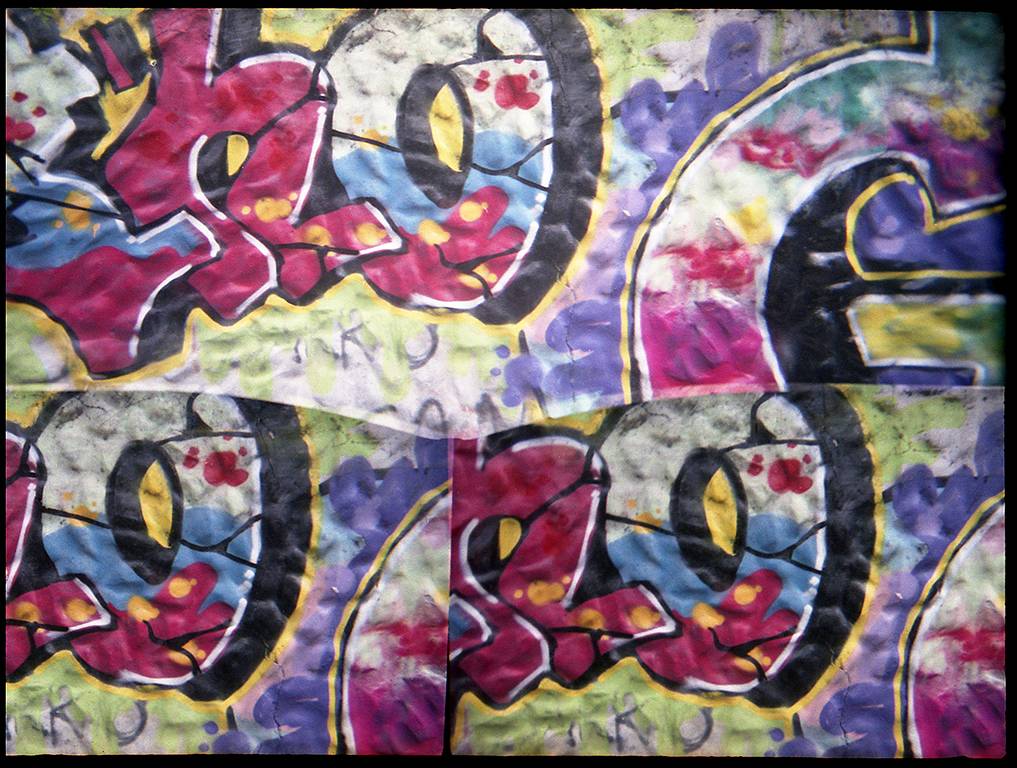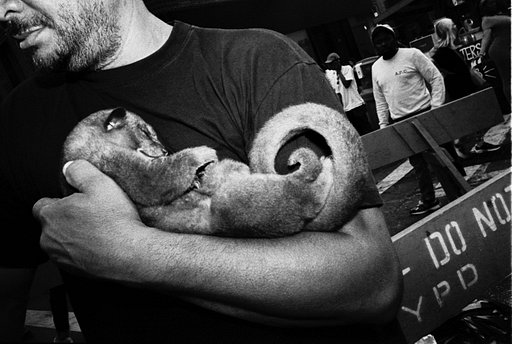The Street Art Deluge in Buenos Aires, Argentina
3 10 Share TweetA long-time fan of plastic cameras, Argentinean writer and photographer Lorraine Healy is the author of “Tricks With A Plastic Wonder,” a manual for achieving better results with a Holga camera. In this article, Healy shares some images and her sheer perplexity at the barrage of awesome street art in her native Buenos Aires, Argentina.

How did this happen? How did the city where I grew up, with its historical political graffiti in plain black aerosol (which was occasionally very funny), blossom into this street art mecca, where every wall slightly longer than usual is covered overnight in wild portentous colors? Every time I come to visit, street art seems to have spread from the original “artsy” enclaves of the various Palermos (Soho, Viejo) to pretty much everywhere you look. Not that I am not delighted, mind you! It’s just that I can’t get over the sheer extent of it, and the talent.

Full disclosure: I have been inordinately fond of graffiti, visual and verbal puns on walls, writings on bathroom stalls, and wacky-to-bawdy humor since I was a teenager. While spending vacations in Ireland at my grandparents’, I would write down in notebooks the hysterically comic wisdom found in public bathrooms, train stations and public spaces. I even bought several books that collected all of these unclassifiable bits of anonymous wit, as found all over the United Kingdom.

When I got to college (the School of Philosophy and Letters of the National University of Buenos Aires), I happened to land on one of the most politicized places in Argentina, even when politics was supposedly outlawed. To say nothing of witticisms in the form of aerosoled graffiti! In spite of heavy police presence in the corridors of our school, clever people would outsmart the cops and there would be delightfully explicit slogans sprayed on walls (THE END OF THE WORLD IS NEAR: LET US REJOICE & F*CK!! is one that has stayed in my mind, for some reason). But that’s all it was: huge letters sprayed with black paint on a city wall. After the return of democracy in 1983, and around every cycle of election, these black painted slogans would cover the city, and philosophically blasé property owners would whitewash their walls until the next one. Or instead of actually painting, there would be thin paper posters glued on the walls (sometimes in competing layers, which would in turn generate “peeling artists” who selectively removed pieces of paper for a very nice urban collage effect). Mostly it was stuff that looked like what you can see in these images:


Of course, street art was no news in other parts of the world. London’s Shoreditch was a hopping hotbed of color, art, and political statement long before anyone had heard about that mysterious son of the street-art town of Bristol, Banksy. Current street art destinations the globe are Athens, New York, Melbourne, Valparaíso, Barcelona, Taipei, Berlin, etc. Perceived as vandals in some places, starting out as gang “taggers” in others, street artists seem to have a special radar for cities with abandoned factories, long brick walls guarding railroad yards, subway tunnels and trains.

One of the reasons Buenos Aires has become such a destination for street artists from everywhere is that there are no city regulations to contend with unlike most places worldwide. All you need is the property owners’ permission to use their walls as your canvas. With the catastrophic financial and economic crisis that culminated in late 2001, a huge amount of factories and stores closed down. At the same time, isolated incidents of break-ins and looting led to those store-owners still in operation to invest on heavy metal curtains to protect doors and windows to their businesses. I suspect this was a match made in street art heaven. Rather than have their metal curtains defaced and made ugly with cryptic punk symbols or anarchists’ insults, business people approached by artists were extremely willing to give their okay to enormous murals encompassing their walls, shop windows and doors.

Close to where my Mom lives, there had been plans years ago of building an elevated highway into town. Entire areas four-city-blocks wide were vacated by eminent domain and huge parts of buildings taken down. But the highway plan was abandoned which left swaths of partially demolished city blocks, their long internal walls revealed, up for grabs. Street artists from Europe and Australia have been journeying to Buenos Aires and hooking up with local street artists to create enormous pieces of art. Some are of such scale that you really need an aerial perspective to fully appreciate the effect.

I know that in some photographic circles, shooting graffiti, street art, vintage signage, and anything already graphic is considered not serious, “lazy” work—but so sue me! I love shooting this stuff. I find the basic Holga N a natural match to photograph this kind of work but the Sprocket Rocket is an awesome choice as well. I have used the Disderi Robot camera with great results, too, and I’m sure any of the Lomo samplers would work wonders. And, if the light is not insanely bright (currently it is, here in Buenos Aires), Polaroid and Lomo'Instants will make you want to weep with joy.

As for film, anything reliably punchy that will match both the available light and the usually hyper-saturated contents of the work will be well suited. Use your favorites, even black and white will yield awesome results. You can move in close, shoot the details of something like this mail-slot surrounded by painted fruit, take a middle distance view like this street sanctuary to a popular saint, or go abstract like the mural shot below, left.

Next week I’m going on a street art tour, three hours being chauffeured in a van surveying the newest creations on the south side of the city. Tomorrow, my indefatigable goddaughters Marina and Fía are taking me on their home made walking tour of street art near our neighborhood on the north side of town. Stay tuned!
Lorraine Healy (@lorrainehealy) is an Argentinean writer and photographer living in the Pacific Northwest. A long-time fan of plastic cameras and she is the author of “Tricks With A Plastic Wonder,” a manual for achieving better results with a Holga camera, available as an eBook from Amazon.com.
written by Lorraine Healy on 2017-03-07 #places #lifestyle #travel #medium-format #graffiti #120 #35mm #street-art #color #holga-n #disderi-robot #holga-pan-120 #argentina-buenosaires
















3 Comments